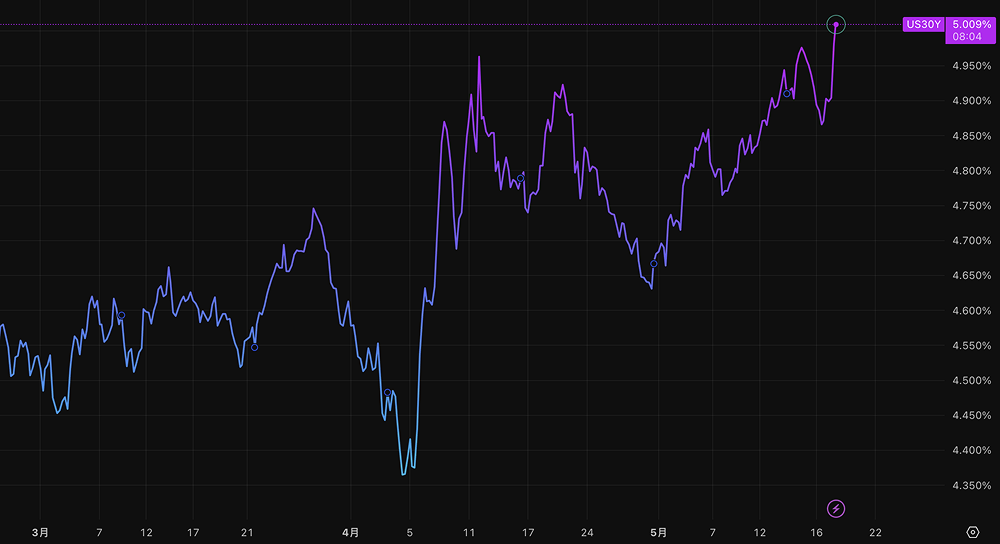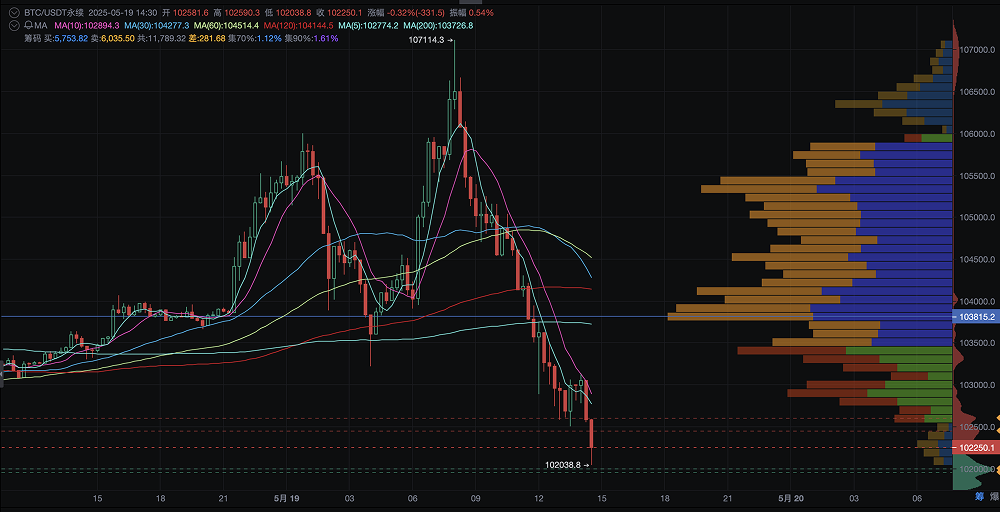On May 17, 2025, the international credit rating agency Moody's announced that it has downgraded the U.S. sovereign credit rating from the highest level of Aaa to Aa1, citing the continuous rise in U.S. government debt and the worsening fiscal deficit. This decision marks the complete loss of the top credit rating from the three major rating agencies (Moody's, S&P, and Fitch) for the United States, triggering tremors in the global financial markets. U.S. stocks fell in after-hours trading, Treasury yields surged, and cryptocurrencies like Bitcoin experienced a spike followed by a drop, while Asian investors showed increased risk aversion. The market is holding its breath for the real game after the U.S. stock market opens.

Cloud of Debt Crisis: Why Did Moody's Strike Hard?
In a statement on May 16, Moody's pointed directly to the core of the U.S. fiscal predicament: lawmakers have failed to effectively curb annual deficits or cut spending, leading to a continuous expansion of the national debt. According to data from the U.S. Treasury, by January 2025, U.S. government debt had surpassed $36 trillion, accounting for more than 120% of GDP. Moody's noted that over the next decade, with welfare spending increasing and tax revenue growing only modestly, the fiscal deficit is expected to widen to 9% of GDP.
"Previous U.S. governments and Congress have failed to reach a consensus on reversing the trend of massive fiscal deficits and rising interest costs," Moody's wrote sternly in its report. "While the U.S. economy and the dollar's status as a reserve currency still have advantages, these advantages are no longer sufficient to offset the deterioration of fiscal indicators." The rating outlook was adjusted from "negative" to "stable," reflecting Moody's long-term confidence in the strength of U.S. institutions and the global role of the dollar, but short- to medium-term credit risks cannot be ignored.
It is worth noting that Moody's is the last of the three major rating agencies to downgrade the U.S. rating. Previously, S&P Global Ratings had downgraded the U.S. rating to AA+ back in 2011, and Fitch followed suit in 2023. Now, the United States, as the world's largest economy, has completely bid farewell to the "AAA" halo, raising doubts about its status as the highest-quality sovereign borrower.
Market Tremors: U.S. Stocks, Bond Market, and Crypto Market All Affected
Following Moody's downgrade decision, the financial markets reacted swiftly. In after-hours trading, the S&P 500 ETF fell by 1%, and the Nasdaq 100 ETF (QQQ) dropped by 1.3%. The yield on the U.S. 10-year Treasury bond surged from 4.44% to 4.48%, while the yield on the 30-year Treasury bond briefly touched 5%, currently reported at 4.992%. The ICE U.S. Dollar Index briefly fell by about 15 points, indicating a subtle shake in market confidence in the dollar.

The crypto market was also not spared. After a spike during the low liquidity period over the weekend, Bitcoin faced selling pressure as the CME opened, failing to hold its high position. Ethereum and other altcoins followed suit in retreat, with some whales' high-leverage operations thwarted. Industry analysts believe that the risk-averse behavior of Asian investors is the main reason for the decline, but the main trading period after the U.S. stock market opens will determine the market's subsequent direction. Historical data shows that downgrades in credit ratings typically have a short-term impact on the market, but the current uncertainty amid high debt levels keeps investors on alert.

Debt Vortex: A "Fiscal Nightmare" of $36 Trillion
The U.S. debt crisis is not a new topic, but its scale and speed are alarming. At the beginning of 2025, the federal budget deficit approached $2 trillion annually, and interest payment costs surged, squeezing fiscal space. Moody's warned that persistent high deficits will exacerbate the burden of government debt and interest, and if investor confidence in U.S. Treasuries declines, bond yields could rise further, leading to a spiraling increase in debt servicing costs.
Recently, business leaders like Tesla CEO Elon Musk have called for cuts in federal spending, but the effects have been minimal. Market observers point out that current fiscal proposals lack substantial deficit reduction measures, and the political deadlock further exacerbates the problem. The White House criticized Moody's decision, claiming it underestimated the resilience of the U.S. economy, but Wall Street strategists generally view the downgrade as a "warning signal" regarding the fiscal situation, which could trigger profit-taking.
Global Impact: Testing Dollar Hegemony and Market Confidence
Moody's downgrade decision not only concerns the U.S. domestically but also poses a challenge to the global financial system. The dollar's status as the global reserve currency relies on U.S. credit, and the downgrade by all three major rating agencies undoubtedly undermines this foundation. Some analysts worry that if the debt crisis continues to worsen, it could shake the dollar's dominant position in international trade and finance, raising global borrowing costs.
For the crypto market, the downgrade has intensified risk aversion in the short term, but in the long run, some investors may view assets like Bitcoin as a hedge against fiat currency risks. However, the current liquidity crisis in altcoins and the setbacks faced by whales indicate that the market has not yet emerged from the volatility range.
Future Outlook: The Game Has Just Begun
Market participants generally believe that the impact of Moody's downgrade will become more apparent after the U.S. stock market opens. Historical experience shows that when S&P downgraded the U.S. rating in 2011, the market experienced short-term turbulence but quickly rebounded. However, the current scale of U.S. debt far exceeds that of previous years, and the global economic environment is more complex, making it potentially harder for investor confidence to recover.
"The real game begins when the U.S. stock market opens tonight," said a Wall Street analyst. "In the short term, the market may digest the impact of the downgrade, but the long-term debt issues will continue to trouble investors." Meanwhile, the direction of the Federal Reserve's monetary policy, progress on fiscal reforms, and geopolitical situations will all become focal points for the market.
This article represents the author's personal views and does not reflect the stance or views of this platform. This article is for informational sharing only and does not constitute any investment advice to anyone.
Join our community to discuss this event
Official Telegram community: t.me/aicoincn
Chat room: Wealth Group
免责声明:本文章仅代表作者个人观点,不代表本平台的立场和观点。本文章仅供信息分享,不构成对任何人的任何投资建议。用户与作者之间的任何争议,与本平台无关。如网页中刊载的文章或图片涉及侵权,请提供相关的权利证明和身份证明发送邮件到support@aicoin.com,本平台相关工作人员将会进行核查。




